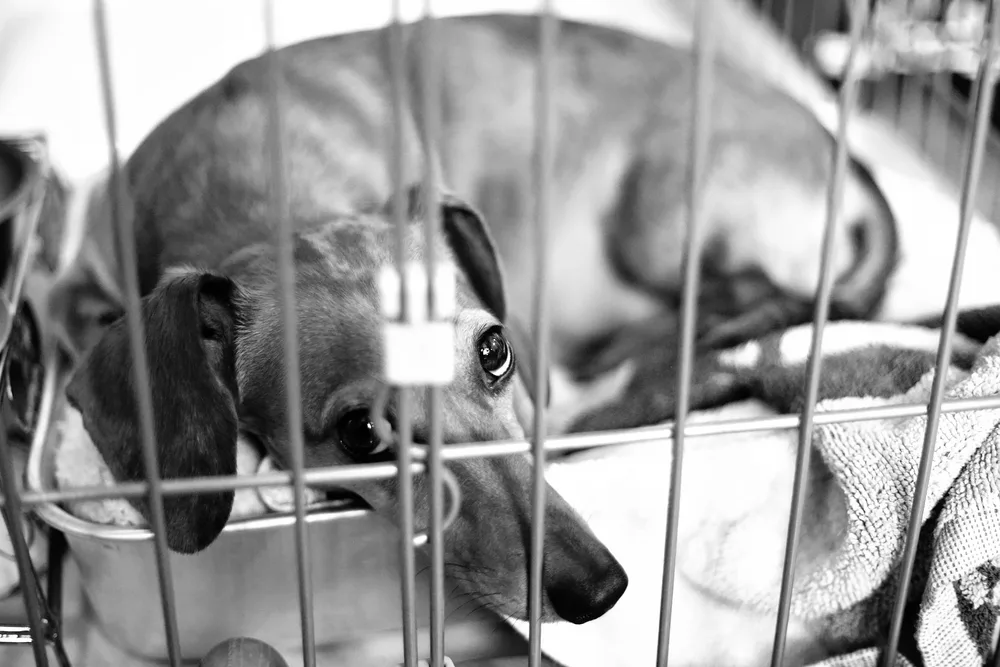Kennel training can be a controversial topic. After all, nobody wants to lock their furry friend away in doggy jail!
However, crate training isn’t cruel or unusual punishment. The key is finding ways to make it positive for you and your pup.
What are the dos and don’t of kennel training for dogs?
Kennel training should be beneficial for your pet and your household. Making it fun and rewarding will give you the best outcome. Approaching crate training with frustration and impatience is a recipe for disaster.
Training your dog to love their crate can save you from home damage and a stressed-out pet. If your dog licks the furniture or demonstrates other anxious behaviors, kennel training could answer your prayers.
There’s a right and wrong way to introduce your dog to their crate. Do the “dos” and avoid the “don’ts” of kennel training for a happy dog and a healthy home.
5 “Do’s” of Kennel Training Your Dog

Teaching your dog to love their kennel doesn’t have to be complicated. If you do it right, most pups will see their crate as their safe space.
My dog, Stella, and her kennel are like a moody teenager and her bedroom. She spends more time in her crate than she does with me! She loves her kennel so much that she takes it upon herself to relax inside it.
I made this happen by making kennel training a positive experience. Please keep reading to learn how I trained my dog to adore her crate.
Do: Practice Crate Time in Intervals
You can’t lock your dog in a cage and leave them for hours. They’ll feel like you abandoned them. If you wouldn’t leave a child in a locked room for hours, you shouldn’t do it to your pet.
Instead, practice crate training in short intervals. The key word here is PRACTICE.
Guide your pet into their crate and let them rest for a few minutes. Once the time is up, come back and show them love.
After your pup learns that you’ll always come back, you can extend their crate time. Run a short errand and return home immediately.
Your furry friend needs to know that you’ll always come back home. Once you prove you won’t abandon them, they’ll relax.
Do: Use Positive Reinforcement
Dogs are more like people than you’d think. Like humans, they respond better to positive reinforcement training.
We wouldn’t blame you for getting annoyed by your dog’s initial whining. However, dogs learn better when you don’t react to poor behavior.
Don’t let those sweet puppy-dog eyes fool you; never reward a crying dog with the attention of any kind. Instead, wait to let them out once they’re nice and quiet.
After a job well done, shower them with lots of love, kisses, and treats. Doing so will help your dog associate positive rewards with their kennel.
Do: Let Them Use the Bathroom Before Training
Potty training and kennel work go hand in hand. You can’t leave your dog in a kennel all day and expect them to hold it!
Make sure you let your puppy do their business before every kennel lesson. Otherwise, you’ll end up with a huge mess and a smelly dog.
Not allowing them to use the bathroom beforehand also teaches them bad behavior. If they continue to potty inside their crate, they will develop a habit that’ll be hard to break.
Holding urine and feces for extended periods is also bad for their health. It strains their kidneys and GI tract and may make them sick.
Start kennel training with an empty bladder and a good attitude. Here’s a potty training timeline to help you along the way.
Do: Make Their Kennel Cozy
Your dog’s kennel shouldn’t look like a jail cell; it should look like a sanctuary! Make it so cozy that they can’t wait to spend time in their personal space.
Add a few blankets to keep them warm. Pillows and a dog bed give them a comfortable foundation to sleep on.
Don’t stop there! Give them toys, enrichment puzzles, and something that smells like you to keep them occupied. The goal is to make their kennel so fun that they can’t wait to spend time in it.
Pro Tip: introduce kennel accessories one at a time. Some dogs chew bedding and toys, making them a choking or obstruction hazard. Customize their kennel to meet their unique needs.
Do: Give Them Enough Space
Choosing the wrong kennel size is one of the most common mistakes I see pet owners making. An appropriately-sized crate gives your dog enough space to move around without leaving room for mess.
A kennel that’s too small won’t be comfortable. It will restrict movement, making it impossible to sit, stand, or lie down.
On the other hand, a too-large kennel also has consequences. The more room your pup has, the greater the risk of having a bathroom accident or injuring themselves on the crate structure.
Your dog’s kennel should give them enough space to circle and stretch their legs. A good rule of thumb is this: the crate should be two inches taller than your pup standing up and four inches longer than your pup lying down.
We made this helpful chart as a reference. In my experience, these breeds do best in the following kennel sizes:
| Dog Breed | Kennel Size |
| Yorkshire Terrier (toy breeds) | 18” x 14” |
| Poodles (small dogs) | 24” x 24” |
| Bulldog (medium dogs) | 36” x 25” |
| Golden Retrievers (large dogs) | 42” x 30” |
| Great Dane (extra-large dogs) | 54” x 45” |
These dimensions will depend on the kennel brand and your dog’s unique height, weight, and length. Choose one that your pup will feel most comfortable in.
5 “Don’ts” of Kennel Training Your Dog

Everyone makes mistakes while kennel training their dogs. However, reducing your errors is essential if you want to teach them quickly.
There’s a lot of conflicting advice on the internet about best practices. Don’t worry; we’ve got the most widely-accepted advice from animal professionals to make training a breeze!
Don’t: Use Crates As a Replacement for Behavior Training
Many pet owners see crates as a punishment rather than a neutral space. You shouldn’t use kennels to discipline your dog.
For example, if your dog scratches the floor or chews your favorite pair of shoes, don’t shove them in their crates for time out. All this does is build negative associations.
Animals don’t understand negative punishments the way humans do. Now, your dog will feel scared the next time your try to crate them.
You’ll also fail to correct their behavior by using the kennel as punishment. Your furry friend won’t make the connection between “bad behavior” and “kennel;” they’ll only feel confused and insecure around you.
Don’t: Leave Small Toys and Bones Unsupervised
Earlier, we said that using toys and other comfort objects helps create cozy kennels. That’s still true; however, you must be careful about particular objects.
Bones and small toys are common causes of choking in dogs. Swallowing them may even cause a bowel obstruction, which requires surgery to clear.
Never leave small pieces of fabric, little toys, and bone fragments with your dog if you’re not around to supervise them. Introduce things to them slowly and see how they do.
Some dogs have no problems with items and learn not to chew. However, others eat everything on site! Pay attention to your pet and supervise them according to their trust levels.
Don’t: Keep Them In Their Collars and Harnesses
Collars and tags are essential identification accessories. However, they don’t belong around your dog’s neck while they’re in their kennel, especially unsupervised.
Harnesses, leashes, and collars can get stuck on bars and kennel locks. Your four-legged friend could choke or sustain an injury trying to get free!
It’s always best to remove these accessories before leaving your dog in their kennel for an extended period of time. However, you can leave them on for short periods as long as you’re home to keep a watchful eye.
Don’t: Use Potty Pads
Potty pads can be a double-edged sword. On the one hand, they protect your floors from bathroom accidents. Conversely, they give your dog mixed signals about where to do their business.
Generally, most professionals agree that potty pads are more harmful than helpful. After all, you don’t want to encourage your dog to use the bathroom in their kennel.
If your dog pees on his blanket inside the crate, you must address the problem rather than mask it. Consider giving them more time outside before putting them in their kennels.
Here’s a helpful video that will teach you how to train your puppy to potty outside!
Don’t: Give Up!
Kennel training can be a frustrating process. Your dog may whine, cry, bark, and paw at the door while adjusting to their crate.
However, you shouldn’t give up! Dogs learn by understanding patterns. If you give in to their noisy behavior, they’ll keep doing it to get their way.
Dogs are much more intelligent than people give them credit for. If you’re consistent with positive reinforcement, your pup should take to their kennel in no time.
FAQs
How long should you leave a dog in their crate?
It would be best if you never left your dog in a kennel for more than a few hours. They need breaks to walk around and use the bathroom. Otherwise, you risk them developing anxiety and poor bathroom habits.
Should you ignore your dog while crate training?
Yes, but within reason. Don’t reward whining and crying with attention. However, keep an eye on your dog in case they have an emergency.
How long do dogs cry in their crates?
It depends on the dog. In the beginning, they may cry for 10-15 minutes before soothing themselves. If they cry for longer, take them out and reintroduce them.
Bottom Line
Kennel training should be a positive experience that makes everyone’s lives better. So, use these crate training do’s and don’ts to build a strong foundation for your pup!
